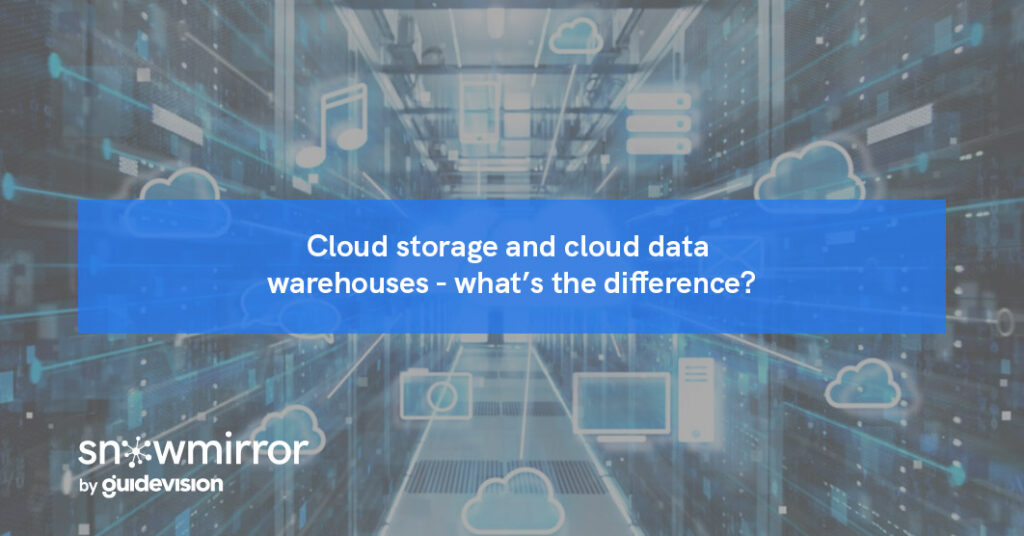Cloud services are growing in sophistication and functionality. Although the two concepts might be generalized under the term ‘cloud storage’ in that you’re saving your data on a cloud service, there is quite a big difference between simple cloud storage – as offered by services like Amazon S3, Google Cloud Storage, and Azure Storage – and data warehouse platforms such as Snowflake, Amazon Redshift and Azure Synapse.
Understanding the difference between the services can help you in making the right decision for your cloud needs. For the sake of easier comparison, this article will focus on Snowflake and S3, but the general concepts are similar for the other services.
In the use case, we’ll look at, we’re replicating data from our ServiceNow instance to our own infrastructure. We’re using SnowMirror to manage that replication because it’s the smart replication solution for ServiceNow. It’s important to note that SnowMirror supports both simple cloud storage as well as data warehouses, so it’s really up to you to determine what your needs are.
Cloud storage and ServiceNow data
When we talk about simple cloud storage, we tend to think of services like Amazon S3, Google Cloud Storage and Azure Storage. These services essentially work like disk drives or old-school FTP accounts: On Amazon S3, users can upload objects (files and metadata) up to 5 GB in size, set access rights, and the files can be made public by HTTP or BitTorrent protocol. Metadata is stored along with the file, and the objects are stored and retrieved using a developer-assigned key; an authentication mechanism keeps the files secure from unauthorized access.
Simple cloud storage may be useful for companies that do not expect to perform a large amount of changes or transforms to their replicated ServiceNow data, or who are looking to use the replicated data as a backup. In this use case, SnowMirror exports .CSV data for simple cloud storage.
But it doesn’t have to be the end of the line for your ServiceNow data. Many of our users use the .CSV file as a sort of intermediate step before their data is stored in a data lake.
Cloud storage and ServiceNow data: Advantages and disadvantages
In terms of advantages and disadvantages, simple cloud storage’s strength lies primarily in cost and simplicity. It’s very easy to get started uploading data to your cloud account, and the costs can be quite affordable – around 2.6 cents per gigabyte per month on S3, for example. Permissions are fairly robust as well, meaning that only authorized users can upload or access files.
However, there are downsides to simple cloud storage. Sharing capabilities are limited, and collaboration features are not available.
We go into greater depth on how ServiceNow data can be used with Azure in our webinar on demand, which you can see here: https://www.snow-mirror.com/webinar-how-to-work-with-servicenow-data-in-azure_25052023/
Data warehouses and ServiceNow data
Data warehouse platforms are a completely different beast. They offer functionality that was previously only found in relational databases. One of the most popular use cases we see for ServiceNow data in data warehouses is that the replicated data is combined with other company data to create a data lake. In this case, SnowMirror exports your data to Snowflake as relational database tables.
If you’re interested in going into greater depth on working with ServiceNow data in data lakes, we’ve got a webinar on this topic, which you can sign up for here: https://www.snow-mirror.com/webinar-replicating-servicenow-data-in-data-lakes-09-2023/
The combined data from the data lake – including your ServiceNow data – can then be used by business intelligence platforms such as PowerBI, Tableau, Qlik, Cognos or others to create highly effective reports and dashboards.
If you’re interested in seeing more on how ServiceNow data can be used with PowerBI, we’ve got a webinar on demand on the topic here: https://www.snow-mirror.com/webinar-connecting-powerbi-to-servicenow/
If you’re a Tableau user, we have a webinar on-demand on integrating Tableau with ServiceNow here: https://www.snow-mirror.com/webinar-integrating-tableau-with-servicenow-1-2023/
Data warehouses and ServiceNow data: Advantages and disadvantages
Data warehouse platforms such as Snowflake have advantages over simple storage primarily in the fact that database functions are baked in. Snowflake, for example, supports standard and extended SQL. It also offers web-based GUI and command-line interfaces, a large number of client connectors, and third-party plugins. Data can be loaded and unloaded in bulk, and security is adequate.
Snowflake’s disadvantages have to do with support for bulk data loading only. If you want to migrate data from files, there isn’t much support available on how to do so. In addition, its features are designed to work with structured and semi-structured data.
If you’d like to further explore the possibilities of replicating ServiceNow data to the cloud, you can download a free 30-day trial version of SnowMirror by filling out this form on our website. We’ll then send you back an email with a 30-day trial license.
